Want it delivered daily to your inbox?
-
The Fed has since the beginning of 2023 steadily increased its estimate of the long-run fed funds rate, see chart below. The implication for investors is that the Fed is beginning to see the costs of capital as permanently higher. A permanent increase in the risk-free rate has important implications for firms, households, and asset allocation across equities and fixed income.
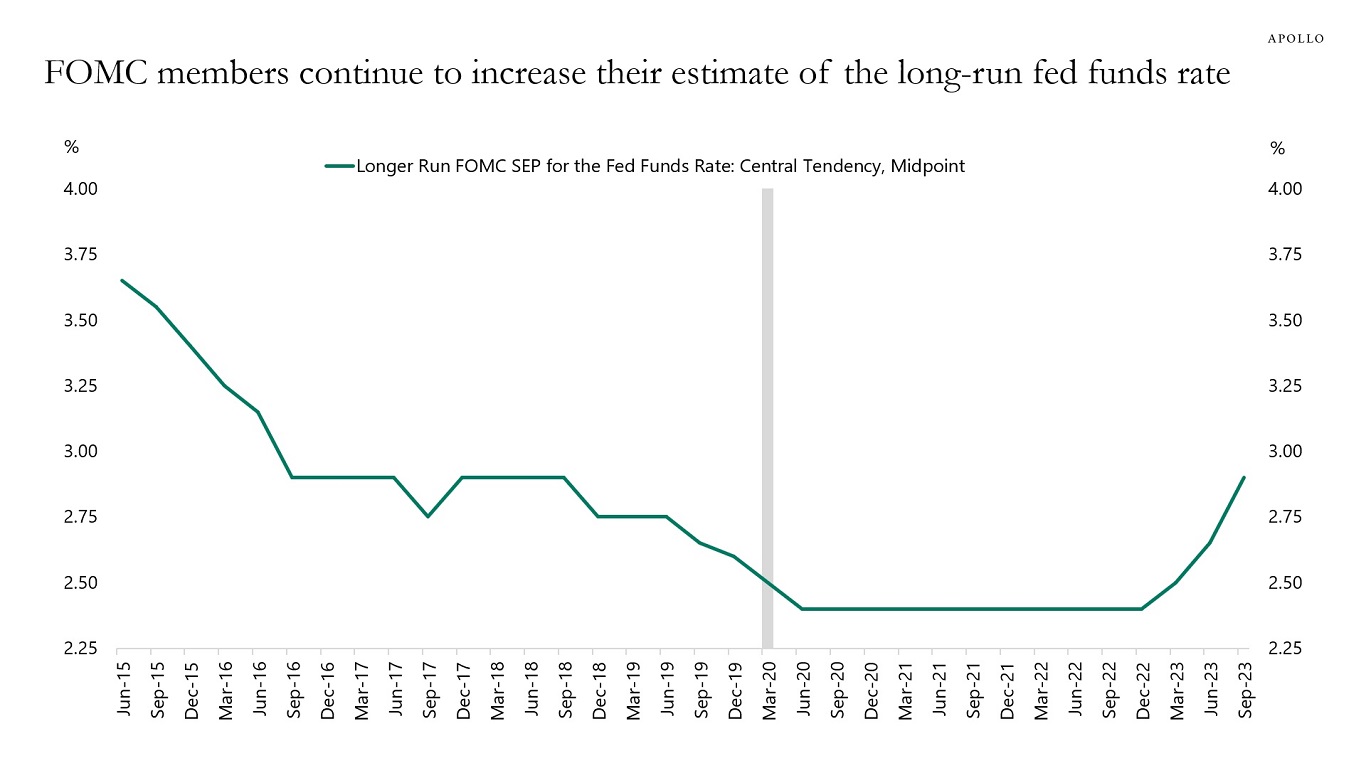
Source: FRB, Apollo Chief Economist See important disclaimers at the bottom of the page.
-
There is downward pressure on buybacks because of worries about a recession, the new tax on buybacks, and higher cost of capital.
These three forces make free cash flow more valuable for companies, see chart below.

Source: Bloomberg, Apollo Chief Economist See important disclaimers at the bottom of the page.
-
Calculating the equity risk premium using trailing earnings and forward earnings shows that stocks are at their least-attractive levels in 20 years relative to bonds, see charts below.
The equity risk premium measures the return in the stock market minus the return of the risk-free rate, and it tells investors something about equity returns relative to fixed-income returns.
In the equity risk premium formula, equity returns are normally calculated by looking at the S&P500 earnings yield, i.e., the inverse of the P/E ratio. Using forward earnings expectations can be misleading when the consensus expects a 55% chance of a recession, so another variant is to look at the S&P500 earnings yield using trailing earnings.
Either way, the bottom line is that with 10-year interest rates close to 5%, the stock market today is more unappealing than it has been in 20 years, see again charts below.

Source: Bloomberg, Apollo Chief Economist 
Source: Bloomberg, Apollo Chief Economist See important disclaimers at the bottom of the page.
-
The market is currently pricing that the FOMC will start cutting rates in June 2024, but the chart below shows that the market is almost always wrong about what the Fed will do beyond the next FOMC meeting.
Looking at the chart, it is remarkable how mean reverting the error is.
When rates are low, the market is systematically pricing that the Fed will soon hike.
When rates are high, the market is systematically pricing that the next move from the Fed is to cut.
Maybe the Fed will cut rates next summer. Maybe not.
For now, investors should be planning on rates staying higher for longer.

Source: Bloomberg, Apollo Chief Economist See important disclaimers at the bottom of the page.
-
Key measures of inflation have reaccelerated in recent months, and supercore inflation at 4% is too high compared with the Fed’s 2% inflation target, see charts below.
The bottom line is that it is too early for the Fed to declare victory over inflation, and the Fed needs to slow down the economy further to get inflation under control.
The implication for investors is that the Fed will keep rates high until nonfarm payrolls go negative, because that is what is needed to get inflation under control, and this fact is generally underappreciated in markets.

Source: BLS, Haver Analytics, Apollo Chief Economist 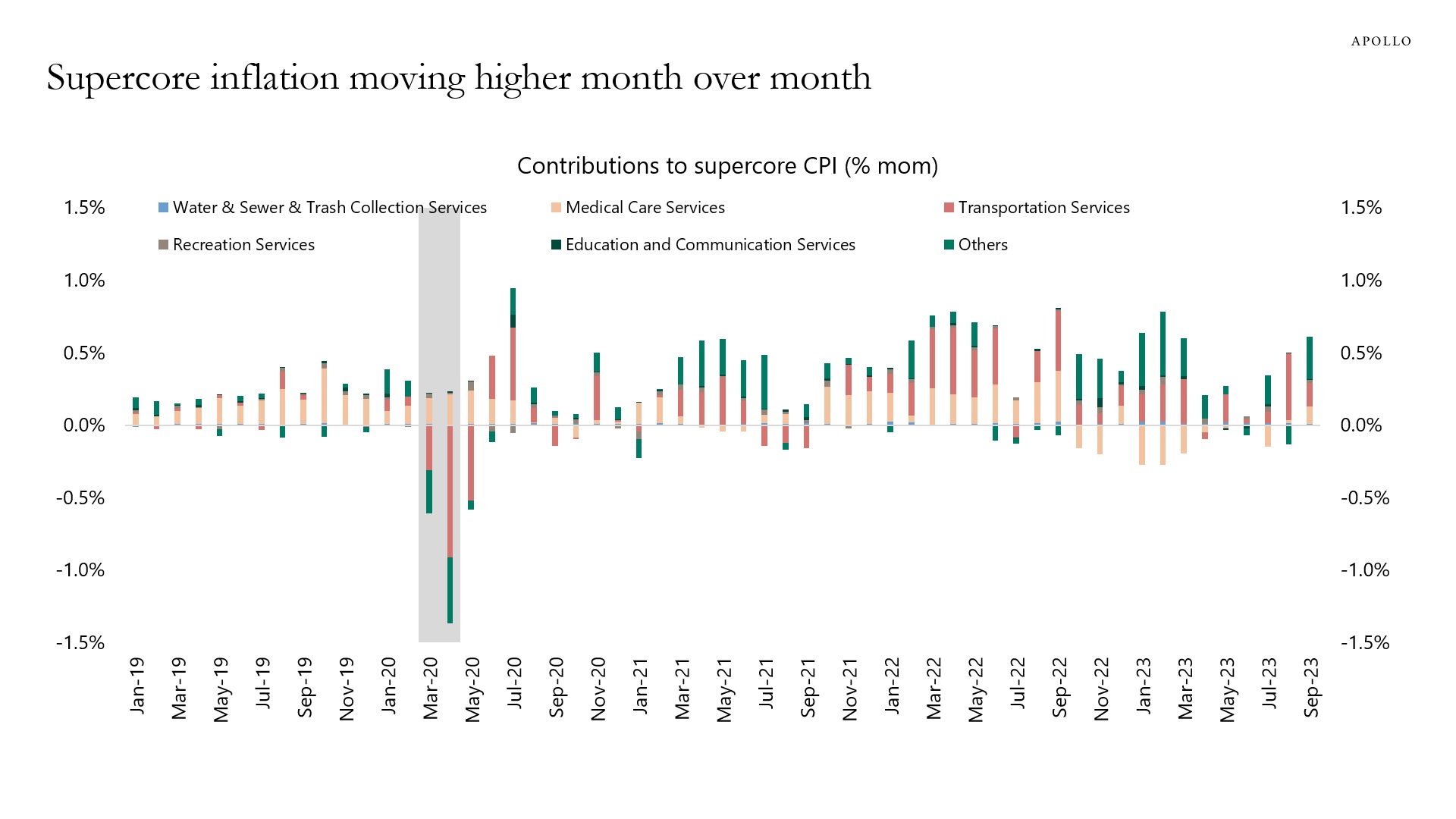
Source: BLS, Haver Analytics, Apollo Chief Economist 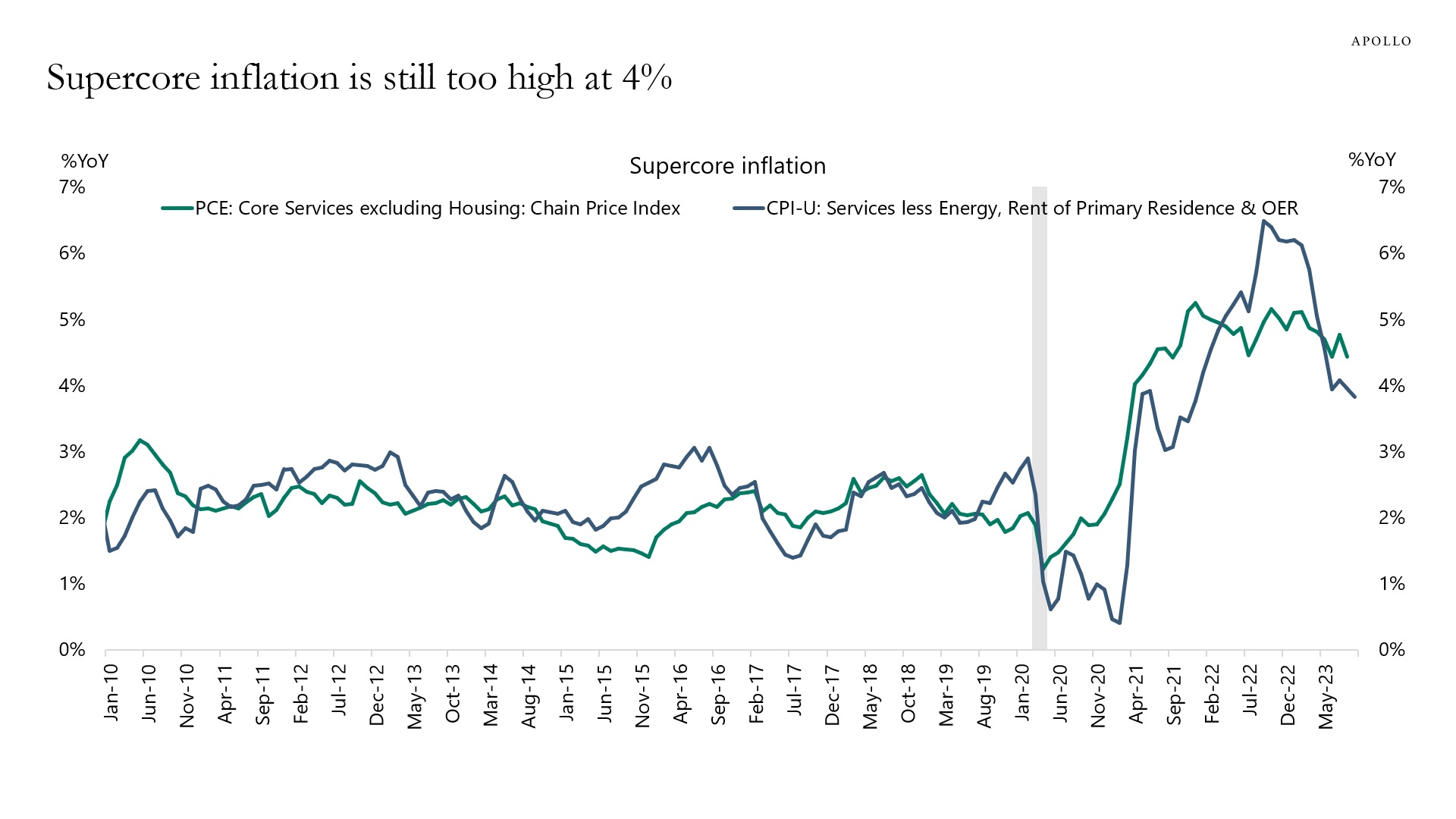
Source: BLS, Haver Analytics, Apollo Chief Economist See important disclaimers at the bottom of the page.
-
The Fed has quantified what their forward guidance and balance sheet policy mean for the fed funds rate, and their estimates show that the proxy fed funds rate is 7% rather than the official 5.5%, see chart below and here.
In other words, comparisons with history and discussions of how restrictive monetary policy is should not only look at the level of the fed funds rate but also include forward guidance and balance sheet policies, including their impact on long rates.

Source: Bloomberg, Apollo Chief Economist. Note: Source: Monthly series of the proxy funds rate, from Doh and Choi (2016) and Choi, Doh, Foerster, and Martinez (2022). This measure uses public and private borrowing rates and spreads to infer the broader stance of monetary policy. When the Federal Open Market Committee uses additional tools, such as forward guidance or changes in the balance sheet, these policy actions affect financial conditions, which the proxy rate translates into an analogous level of the federal funds rate. The proxy rate can be interpreted as indicating what the federal funds rate would typically be associated with prevailing financial market conditions if these conditions were driven solely by the funds rate. See important disclaimers at the bottom of the page.
-
Student loan payments restarted on October 1. And the Census Household Pulse Survey for October shows a jump in the share of consumers saying they are having difficulties paying their household expenses, see chart below.
Looking at the Household Pulse Survey in detail shows that the difficulties with paying household expenses were concentrated among households with a college degree, making between $50,000 and $150,000, suggesting that restarting student loan payments is the source of increased financial stress for consumers.

Source: Census Bureau, Apollo Chief Economist (Note: Household Pulse Survey) See important disclaimers at the bottom of the page.
-
There are 33 million small businesses in the US, and the monthly survey from the NFIB shows that small businesses are now paying 10% interest on short-term loans, see chart below.
In other words, Fed policy is working as the textbook would have predicted, and companies are facing higher costs of capital.
The outcome is lower capex spending and lower hiring.
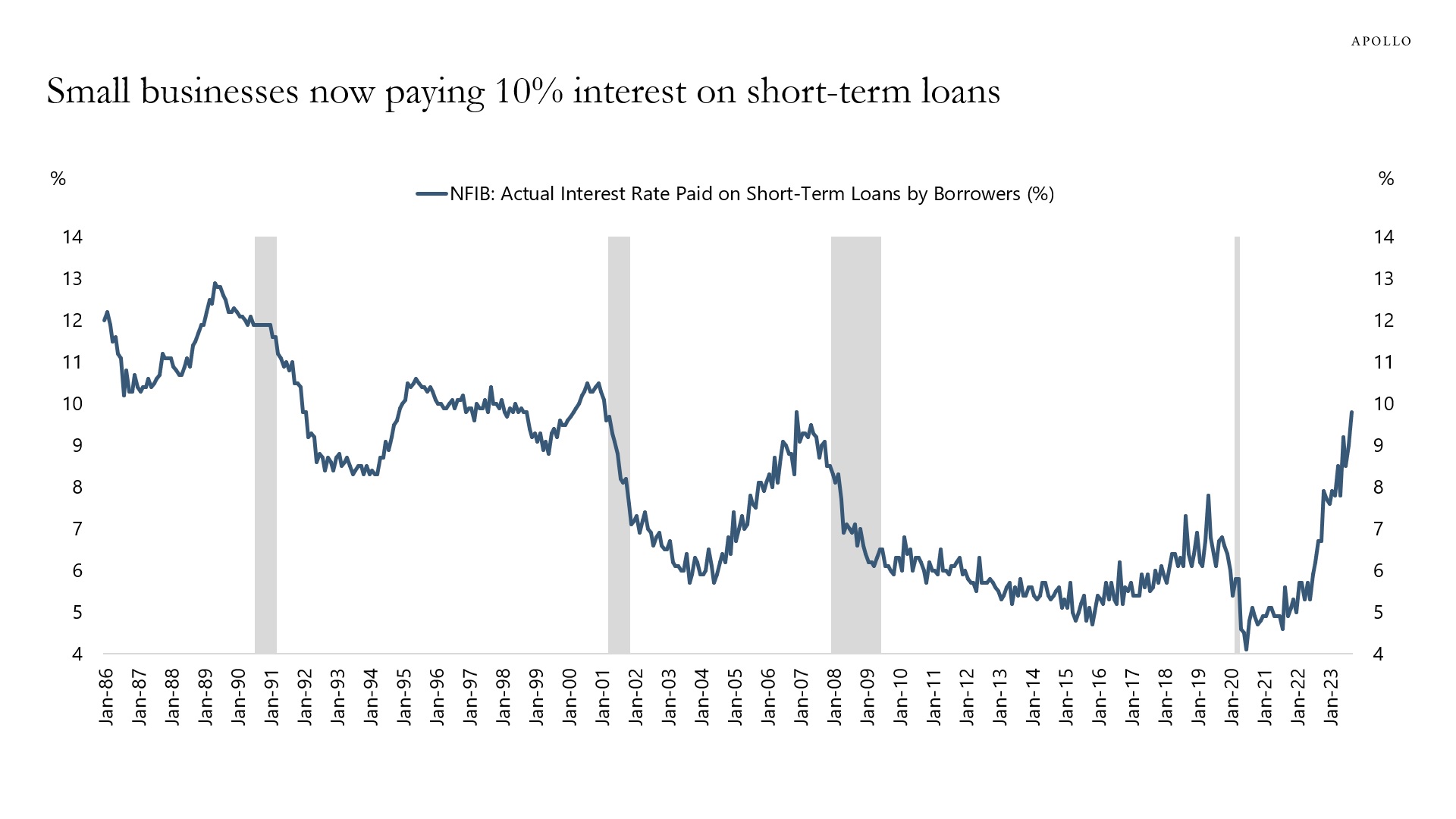
Source: NFIB, Haver Analytics, Apollo Chief Economist See important disclaimers at the bottom of the page.
-
It is more difficult to fire and hire workers in Europe, and the result is more rigid labor markets.
Combined with wages being more indexed to inflation, wage inflation is more sticky in Europe than in the US, see the first chart below.
Because of these structural features, the ECB has to remain hawkish even in a situation where the consensus is starting to see much weaker growth ahead in Europe, see the second chart.
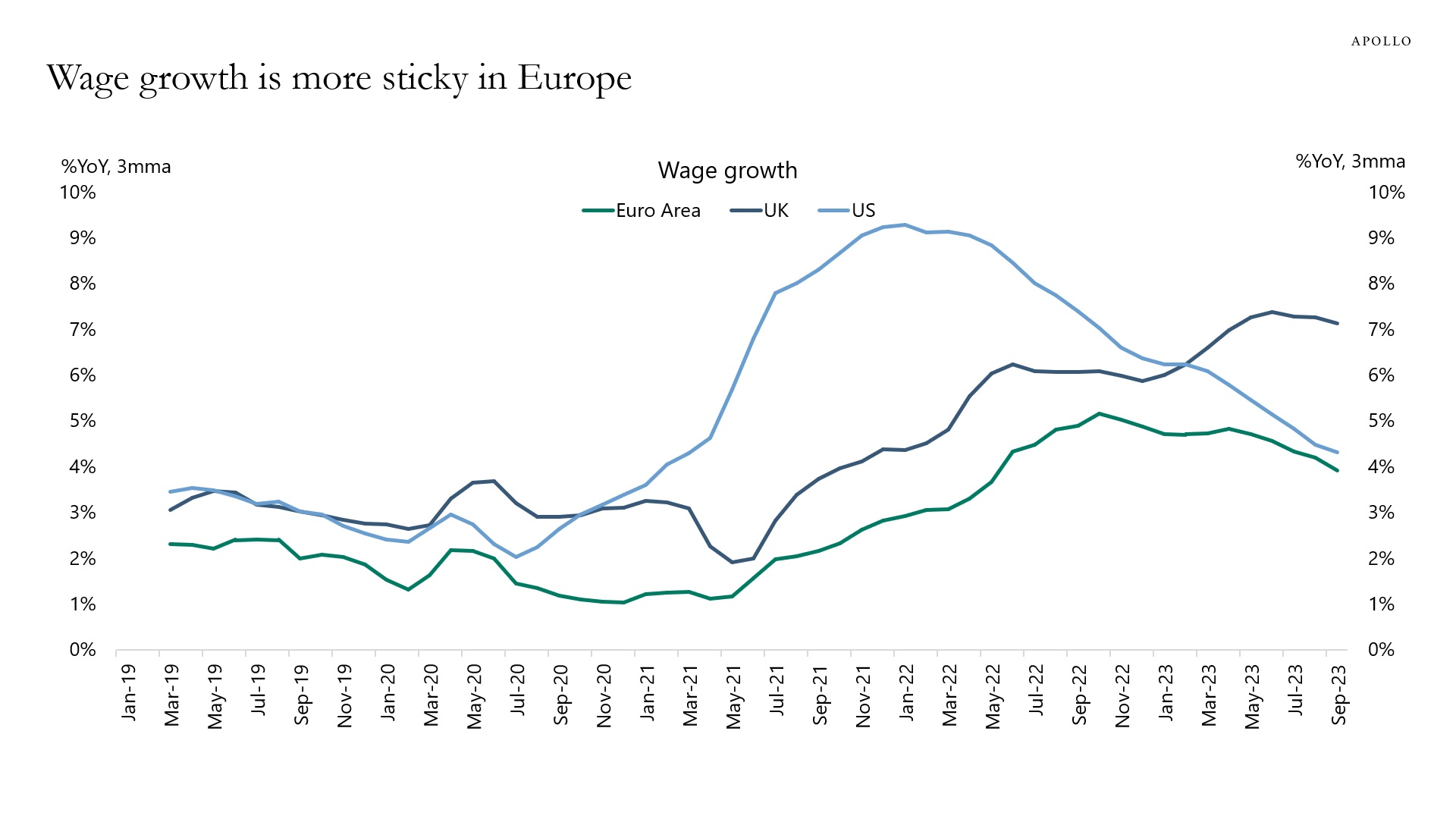
Source: Indeed wage growth tracker, Apollo Chief Economist 
Source: Bloomberg, Apollo Chief Economist See important disclaimers at the bottom of the page.
-
Higher credit yields increase corporate capital costs.
And higher cost of capital puts pressure on coverage ratios and corporate profitability.
With lower coverage ratios and lower profitability, credit risks increase, and the result is that credit spreads should go wider.
That is, however, not what is happening at the moment. The current disconnect between credit yield levels and credit spreads is significant, see chart below.
Maybe what is happening today is similar to what happened from 2003 to 2007, when yield levels kept increasing and spreads stayed very tight, see again chart below. Only when the economic data started weakening did credit spreads begin to widen.
With the Fed trying to cool down the economy to fight inflation, the risks are that credit spreads will widen once the Fed succeeds with pushing the unemployment rate higher.

Source: Bloomberg, Apollo Chief Economist. Note: Index used is LUACTRUU Index. See important disclaimers at the bottom of the page.
This presentation may not be distributed, transmitted or otherwise communicated to others in whole or in part without the express consent of Apollo Global Management, Inc. (together with its subsidiaries, “Apollo”).
Apollo makes no representation or warranty, expressed or implied, with respect to the accuracy, reasonableness, or completeness of any of the statements made during this presentation, including, but not limited to, statements obtained from third parties. Opinions, estimates and projections constitute the current judgment of the speaker as of the date indicated. They do not necessarily reflect the views and opinions of Apollo and are subject to change at any time without notice. Apollo does not have any responsibility to update this presentation to account for such changes. There can be no assurance that any trends discussed during this presentation will continue.
Statements made throughout this presentation are not intended to provide, and should not be relied upon for, accounting, legal or tax advice and do not constitute an investment recommendation or investment advice. Investors should make an independent investigation of the information discussed during this presentation, including consulting their tax, legal, accounting or other advisors about such information. Apollo does not act for you and is not responsible for providing you with the protections afforded to its clients. This presentation does not constitute an offer to sell, or the solicitation of an offer to buy, any security, product or service, including interest in any investment product or fund or account managed or advised by Apollo.
Certain statements made throughout this presentation may be “forward-looking” in nature. Due to various risks and uncertainties, actual events or results may differ materially from those reflected or contemplated in such forward-looking information. As such, undue reliance should not be placed on such statements. Forward-looking statements may be identified by the use of terminology including, but not limited to, “may”, “will”, “should”, “expect”, “anticipate”, “target”, “project”, “estimate”, “intend”, “continue” or “believe” or the negatives thereof or other variations thereon or comparable terminology.






